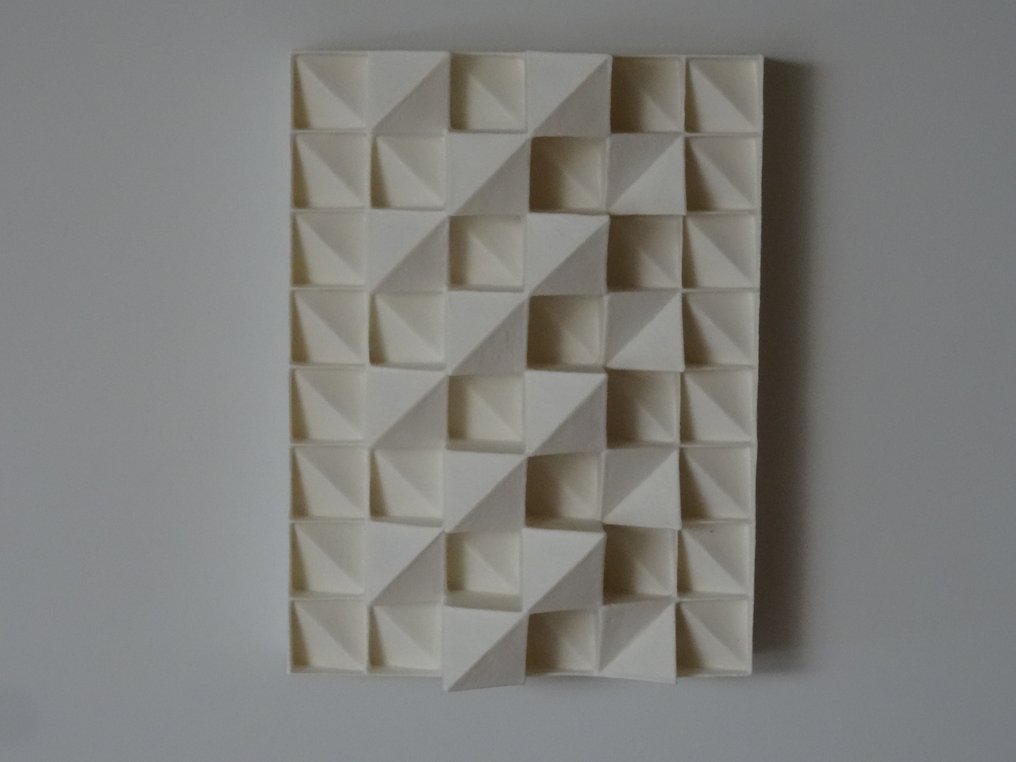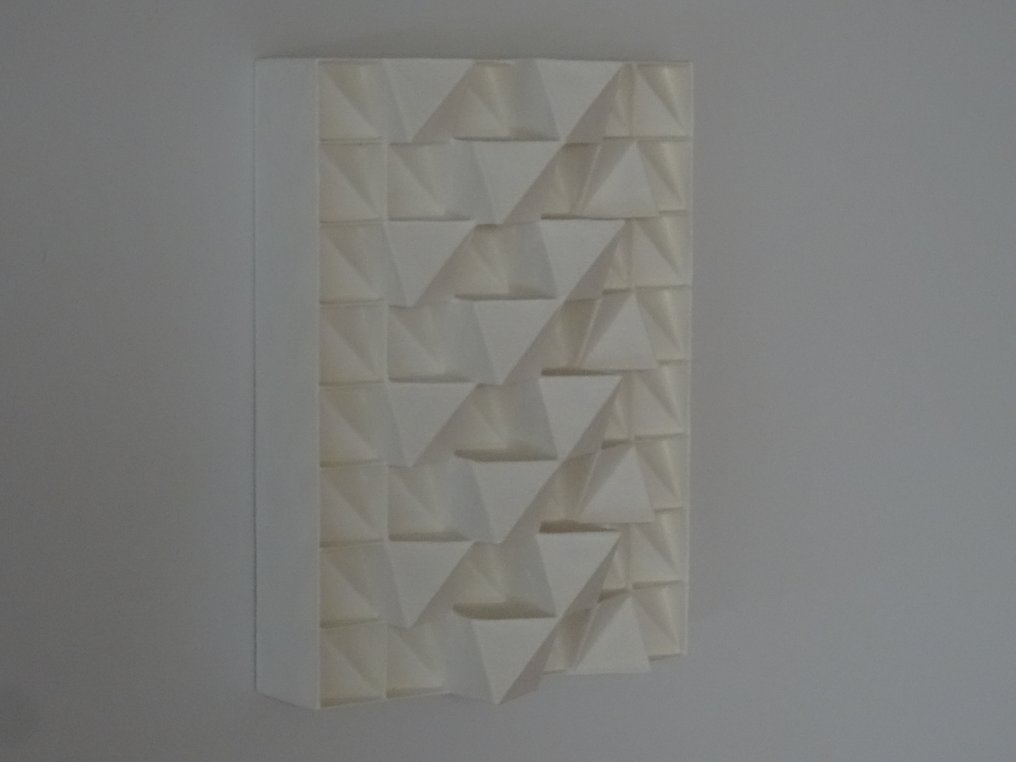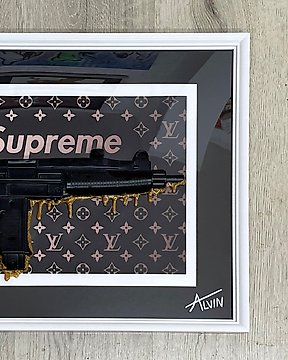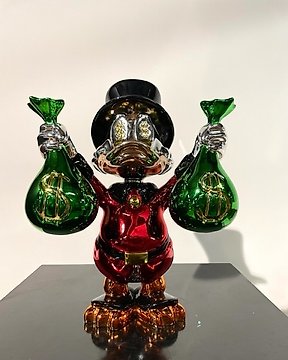Ziet er goed uit! Alles netjes verpakt en goed aangekomen.
Visualizza traduzioneHans Meeuwsen - 2024 - 47 minimalistisch wandrelief
N. 84586653





Het kunstwerk is gemaakt van porselein, oxiderend gestookt op 1240 C. De wanddikte is ongeveer een millimeter, daardoor is er enige transparantie in het porselein.
Aan de achterzijde zit een uitsparing waaraan het werk opgehangen kan worden. Op de eerste vijf foto's met de lichte achtergrond is het object hangend afgebeeld.
Het betreft een uniek handgemaakt object.
De signatuur, in relief, is zichtbaar op de foto's.
De kunstenaar heeft dit werk met twee porseleinen applicaties gesigneerd, een is zijn voornaam en de eerste letter van zijn achternaam, op de andere staan twee Japanse karakters, Raku en Yakimono.
Bij de verzending zal deze kist “box in box” verpakt worden, waarbij de tussenruimte met schokabsorberend milieuvriendelijk materiaal wordt gevuld.
Hans Meeuwsen (1954, The Netherlands) graduated from the Visual Arts Academy in Tilburg to initially become a teacher in visual arts at an upper secondary school. His main specialism was drawing, but he accidentally discovered the potential of clay as a visual arts medium. Rolling, pressing and cutting provided him with little flat clay squares that he used to built cubic shapes looking like hermetically closed cells.
A few years later he received national and international recognition with exhibitions in The Netherlands and Germany. Important works from that time include towers, pyramids and other constructions, some being pure geometric abstractions, others being interpretations of the mythical Tower of Babel. Hans further developped his ceramic skills during residencies at the European Ceramic Work Centre in The Netherlands and working periods in New Zealand, Lithuania and the Japanese Island Hirado.
During the most recent years he has further developped his ceramic skills and works with creamy white wafer-thin slices of porcelain that are mounted into cubes or pyramids. By stacking these geometric shapes in repetitive patterns he creates sculptures that are reminiscent of the Dutch Zero-movement and in particular the works by Jan Schoonhoven, but in the end clearly bears the artists’ own signature. He applies his decades-long experience to create a dialogue between inner and outer space, between geometric and organic, between order and chaos.
Hans Meeuwsen is a “Prix de Rome” nominee of 1987 and a Fletcher Challenge Ceramic merit award winner of 1992 and ever since then his work has found its way to many national and international collections.
Il venditore si racconta
Het kunstwerk is gemaakt van porselein, oxiderend gestookt op 1240 C. De wanddikte is ongeveer een millimeter, daardoor is er enige transparantie in het porselein.
Aan de achterzijde zit een uitsparing waaraan het werk opgehangen kan worden. Op de eerste vijf foto's met de lichte achtergrond is het object hangend afgebeeld.
Het betreft een uniek handgemaakt object.
De signatuur, in relief, is zichtbaar op de foto's.
De kunstenaar heeft dit werk met twee porseleinen applicaties gesigneerd, een is zijn voornaam en de eerste letter van zijn achternaam, op de andere staan twee Japanse karakters, Raku en Yakimono.
Bij de verzending zal deze kist “box in box” verpakt worden, waarbij de tussenruimte met schokabsorberend milieuvriendelijk materiaal wordt gevuld.
Hans Meeuwsen (1954, The Netherlands) graduated from the Visual Arts Academy in Tilburg to initially become a teacher in visual arts at an upper secondary school. His main specialism was drawing, but he accidentally discovered the potential of clay as a visual arts medium. Rolling, pressing and cutting provided him with little flat clay squares that he used to built cubic shapes looking like hermetically closed cells.
A few years later he received national and international recognition with exhibitions in The Netherlands and Germany. Important works from that time include towers, pyramids and other constructions, some being pure geometric abstractions, others being interpretations of the mythical Tower of Babel. Hans further developped his ceramic skills during residencies at the European Ceramic Work Centre in The Netherlands and working periods in New Zealand, Lithuania and the Japanese Island Hirado.
During the most recent years he has further developped his ceramic skills and works with creamy white wafer-thin slices of porcelain that are mounted into cubes or pyramids. By stacking these geometric shapes in repetitive patterns he creates sculptures that are reminiscent of the Dutch Zero-movement and in particular the works by Jan Schoonhoven, but in the end clearly bears the artists’ own signature. He applies his decades-long experience to create a dialogue between inner and outer space, between geometric and organic, between order and chaos.
Hans Meeuwsen is a “Prix de Rome” nominee of 1987 and a Fletcher Challenge Ceramic merit award winner of 1992 and ever since then his work has found its way to many national and international collections.
Il venditore si racconta
- 42
- 0
- 0
Zoals beschreven en perfect ingepakt
Visualizza traduzioneInmiddels 3e werk dat we gekocht hebben. Zou iets moeten zeggen over hoe tevreden we zijn werk en service. Onze dank is wederom groot.
Visualizza traduzionePrachtig werk. Onverwoestbaar verpakt en zeer snel in huis. Onze dank is zeer groot.
Visualizza traduzionePrachtig werk en supersnel in huis. Onze dank is groot!
Visualizza traduzioneBellissimo!! I love it!
Visualizza traduzioneVery nice piece! Thank you!
Visualizza traduzioneSnel & zeer goed verpakt! Het is een erg mooi werkje, erg blij met deze aanvulling aan de muur.
Visualizza traduzioneWederom een prachtig kunstwerkje, snelle verzending en erg goed en veilig ingepakt. Heel erg blij mee.
Visualizza traduzioneSnel, goed en secuur
Visualizza traduzioneSnel en goed geregeld. Secuur verpakt.
Visualizza traduzioneEen prachtig kunstwerk. En een zeer vlotte verzending. Veel dank, het werkje krijgt een mooie plaats.
Visualizza traduzionemooi werk goed verpakt, goed contact gehad met verkoper over verzending. nogmaals dank voor deze.
Visualizza traduzioneOpera bellissima, L ho regalata a mio marito che ha apprezzato tantissimo . Complimenti Grazie Simonetta
Visualizza traduzioneWederom prachtig, zeer snelle en perfecte levering
Visualizza traduzioneSuper stevig verpakt! Heel snelle levering. Mooi werkje! Wij zijn blij!
Visualizza traduzioneEen prachtig kunstwerk!
Visualizza traduzioneTodo ok. Muy bien empaquetado
Visualizza traduzioneTodo ok. Muy bien empaquetado. Gracias
Visualizza traduzioneReally beautiful piece oh art!!
Visualizza traduzioneKlein maar machtig 😃👍 Very nice artpiece!
Visualizza traduzioneHet kunstwerk is in het echt mooier dan op de foto's . Geweldig werk ! Wij gaan genieten!
Visualizza traduzioneCorretto e puntuale
Visualizza traduzioneFantastic artwork! Perfect and quick delivery!
Visualizza traduzionetrès satisfaite
Visualizza traduzione- 42
- 0
- 0
Ziet er goed uit! Alles netjes verpakt en goed aangekomen.
Visualizza traduzione








